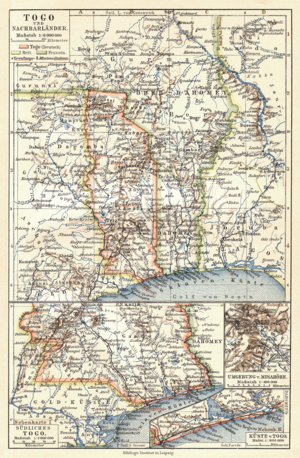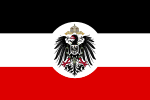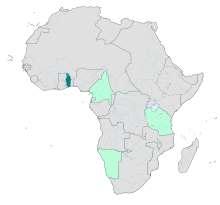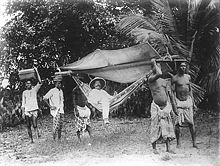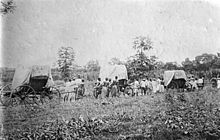German colony of Togo
|
German colony / protected area of Togo (today independent as Togo and part of Ghana ) |
|||||
|---|---|---|---|---|---|
|
|||||
| Capital : | Berlin , German Empire | ||||
| Administrative headquarters: | 1884–1886 Bagida 1886–1897 Sebbe (Zébé) from 1897 Lomé |
||||
| Administrative organization: | |||||
| Head of the colony: | 1885–1888: Kaiser Wilhelm I. 1888: Kaiser Friedrich III. 1888–1899: Kaiser Wilhelm II. |
||||
| Colony Governor: | see List of Governors of Togo | ||||
| Residents: | approx.1,000,000, 100 Germans (1900) 320 Germans (1912) |
||||
| Currency: | 1 gold mark = 100 pfennigs | ||||
| Takeover: | 1884 - 1914 or 1919 | ||||
| Today's areas: | Togo and parts of Ghana | ||||
The German Colony Togo , also just Togo , Togoland or German Togo , was a German colony (also a protected area ) from 1884 to 1916 . The area at that time comprised the present Republic of Togo and the easternmost part of present-day Ghana and had an area of approx. 87,200 km².
The history of the creation of the German colony
As early as 1857, the first Hanseatic trading companies established factories on the slave coast , which from 1882 was connected to the German Empire by regular steamship services on the Woermann line. On July 5, 1884, Plakkoo, the staff bearer (= deputy) of King Mlapa III, who was presumably deceased at that time, and Gustav Nachtigal signed a " protection treaty ", with which individual places in what is now Togo have been declared a " German protected area ". On September 5, 1884, a "protection treaty" followed with the King of Porto Seguro (today: Agbodrafo ). After an agreement with France in 1885, the town of Anecho (also known as "Klein-Popo" until 1905) came to Germany . From 1886 the partly violent conquest of the northern hinterland began. In 1888 Ludwig Wolf founded the Bismarckburg station . The Misahöhe station was founded in 1890 .
From 1891 Togo was no longer under the German administration of the Cameroon colony . In 1894/95, the colonial official Hans Gruner led an expedition to the lower Niger on behalf of the German Togo Committee in order to conclude protection treaties with the wealthy there. This was intended to expand Togo by a multiple of its former size. Gruner and his companion Ernst von Carnap-Quernheimb signed supposed "protection treaties" with heads of the kingdoms Gando ( Nupe and Ilorin ) and Gurma ( Matschakuale and Pama ). In a treaty with France in 1897, Germany renounced both areas. Togo only grew north to the region around Sansane-Mangu , where a station was built in 1896. In 1897 the administrative seat of Togo was moved from Sebe to Lomé .
Through border agreements with the neighboring colonial powers France (1887, 1897 and 1912) and Great Britain (July 14, 1886, July 1, 1890 and November 14, 1899), Togo received its characteristic shape over time. The last issue that was resolved in the Samoa Treaty in 1899 was the division of the so-called Salaga area between Germany and Great Britain, which between 1889 and 1899 was a neutral area between the British Gold Coast and the German colony of Togo.
Military formations like the protection troops were not stationed in Togo. Between 1895 and 1899 there were several small uprisings that were suppressed by police units. In 1897/98 the colonial police force consisted of a commander, three NCOs and 150 locals, which was expanded to 2 officers, 6 NCOs and 550 African police officers by 1913. At this time, a major Dagomba uprising was also suppressed and the country subdued. A mass grave of fallen Dagomba warriors can still be seen near the city of Yendi .
Planned icons for Togo
→ Main article: Flags in the colonies of the German Empire
In 1914, a coat of arms and a flag were planned for Togo, but were no longer introduced due to the start of the war.
The "model colony" of Togo
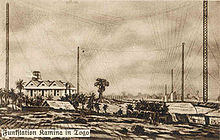
Togo was considered the " model colony " of German colonial history . Here the colonial rulers made greater efforts in the field of education and health (e.g. vaccination campaigns against smallpox ) than in the other colonies. Three railway lines were built: the coastal railway (1905), the inland railway (1907) and the hinterland railway (opened in 1913). Togoland was also considered exemplary in the field of road construction.
The locals were initially just as largely without rights here as in the other German colonies and z. B. exposed to corporal punishment . There was , for example, a colonial scandal surrounding Geo A. Schmidt , who during his time as district manager in Atakpame between 1900 and 1904 raped numerous girls and had villages devastated . Nevertheless, in 1902 there was an ordinance to eliminate domestic slavery and, from 1907, surveys and studies to create a "native law". An ordinance of 1906 allowed schools to use the national language in addition to the German language.
Togo's reputation as a “model colony” was based primarily on the fact that it was the only German colony that had an almost balanced financial balance from 1900 onwards. The main income came from customs duties and the introduction of poll tax for natives in 1907. Income from poll tax amounted to 57,000 marks in 1907 and 853,000 marks in 1912. In 1912 there were 11.4 million gold marks on the import side, compared with 10 million marks in exports. However, this balance has already deteriorated in the last few years of German colonial rule due to the ruthless exploitation of the country's natural resources. After z. For example, if almost all the elephants in the area had been shot down, the export product ivory was naturally also dropped . The term “model colony”, which is historically associated with German Togo , is therefore viewed by critics as part of German colonial propaganda .
Togo was of relatively great importance for communications and traffic connections with Germany and the other African colonies. A telegraphic connection with Europe had already existed since 1894. A large radio station opened in Kamina in 1914 and a direct submarine cable running through Monrovia were important facilities for ensuring the flow of information abroad. In addition, there was the Togblekovhe radio station in the hinterland of Lomé , which was mainly used for communications with coastal shipping .
Agriculture
In 1900 the Colonial Economic Committee (KWK) commissioned the systematic promotion of cotton cultivation in Togo. In order to organize the cotton industry according to a model that was considered modern at the time, the KWK worked with Tuskegee University in Alabama under Booker T. Washington . The institute was a training center for African-Americans whose methods were now to be used in southern Togo. Washington put together an expedition of Tuskegee graduates to assist the German overseers in Togo. Seed breeding systems were used to optimize the local cotton crops. The Sea-Island variety , type Ho , was particularly successful . In Nuatjä , South Togo, a cotton school was set up in 1902 to ensure that new cotton fields were professionally cared for. In 1907 it was expanded to become a general agricultural school and in 1912 to become a state cultural institution. Young Togolese between the ages of 17 and 23 were able to complete three-year agricultural courses in Nuatjä. The transfer of the socio-economic structures from the southern states to southern Togo also led to resistance among Africans. The CHP experiment involved interfering with the local work culture and social structure: unlike in the USA, traditional mixed cultivation instead of monoculture was practiced in Togo . The cultivation and spinning of cotton among the Ewe was carried out by women instead of male farm workers. The German government exerted pressure to prevent a "relapse" into traditional economic practices.
trade
While domestic trade was almost entirely in the hands of locals, foreign trade was largely carried out by European trading houses. The main products exported from Togo were palm oil , palm kernels , corn , rubber and cotton . By-products included ivory , cocoa , coffee , peanuts , copra , coconuts , pepper , live animals, and hides. About two thirds of the products were exported to Germany. Textiles, spirits , wood and wooden goods, tobacco , cigars , material goods and iron goods were imported .
From an economic point of view, the economic value of the Togo colony for the German Reich was rather low and made up around 7.8% of the total colonial trade.
Infrastructure
During the German colonial era, three railway lines with a total length of around 320 km and 1 m gauge were built in Togo . In 1905 the Lomé – Aného railway was opened with a length of 44 km. The Lome-Agome-Kpalime line (119 km) was opened on January 27, 1907. Finally, a connection between Lomé and Atakpamé (160 km) was built. The main and port of Lomé, where the three railway lines met, formed the railway junction. The tracks reached out to the landing stage , which became the sea-side entrance gate to the colony.
Shipping with Europe took place three times a month in 1899 through Hamburg and Liverpool steamers. In 1911, the ship fleet comprised 327 ships with 577,000 register tons .
The German post office in Togo was not subordinate to the colonial administration, but independent. The first two German post offices were opened in Klein-Popo in 1888 (Anecho from 1905) and in Lome in 1890. At the end of 1913, six Germans and 42 African officials were employed. The 16 public post offices and telegraph companies were mainly in the south of the colony. In 1913 almost 600,000 letters were sent from Togo. The post office in Lomé also housed a branch of the German-South American Cable Society , which connected Lomé with Europe and South America by submarine cables.
Administration and administration of justice
At the head of the administration of the colony stood the governor of Togo, who from 1898 had the title of governor. In 1912, Togo was administratively divided into four districts and four independent stations in the hinterland.
The first instance administration of justice against the European population was exercised by the district court in Lomé, the higher court of the colony of Cameroon was responsible as an appeal instance. Due to the small European population, Togo did not have its own higher court.
In relation to the indigenous population, the administration of justice for lighter offenses was carried out by the tribal chiefs themselves. In the case of more serious offenses, the district official in whose district the criminal act occurred was responsible. An appeal to the district official and not to the district court was possible against decisions of the chiefs. The death penalty had to be approved by the governor.
History after German rule
The colony was quickly conquered by its neighbors after the outbreak of World War I. On August 27, 1914, Togo was officially handed over to the British.
In 1916 Togo was divided between Great Britain (33,000 km²) and France (54,000 km²). With the Treaty of Versailles in 1919, Germany finally lost its colony and French Togoland and British Togoland became League of Nations mandates . After the Second World War , it became a UN trust territory .
In 1952, representatives of the Ewe suggested to the UN Trustee Council in a memorandum that Germany should reunite the halves of the country administered by Great Britain and France and lead them to independence (see also German Togobund ). However, the initiative was not taken up. In 1956 British Togoland was annexed to Ghana after a referendum. The French part voted for internal autonomy .
In 1960 French Togoland became an independent Republic of Togo. The government of Togo invited the last German governor, Duke Adolf Friedrich zu Mecklenburg-Schwerin , to the independence celebration .
German is still taught in many schools in Togo today.
Reverberations in German street names
- In Berlin-Wedding is located in the so-called African quarter the Togostraße. She crosses u. a. Petersallee and Nachtigalplatz , which were named after German Africa explorers . Since 1986, however, Petersallee has been reminiscent of Hans Peters (lawyer, politician and resistance fighter) and no longer of Carl Peters . After the Togostraße, an adjoining allotment garden was renamed “Togo permanent colony” in 1939, with the name “permanent colony” resulting from the building law. Because of the similarity of the name to the historical colony of Togo, the facility was renamed "Permanent Allotment Association Togo" in 2014.
- In Munich-Waldtrudering there is - in addition to many other street names with reference to the German colonial era in and outside Africa - a Togo street.
- There is also a Togostraße in the so-called Africa district in Cologne 's Nippes district in the immediate vicinity of Gustav-Nachtigal-Straße. It forms the extension of Kamerunstrasse.
- In Duisburg-Buchholz there is the “Afrikasiedlung”, in which there is also a Togostraße that borders on Lomestraße.
- In Hanover-Badenstedt there is an “Africa Quarter” with a Togo path.
- In the east of Kassel , the urban settlement, popularly known as the "Africa settlement", was built in the Forstfeld district at the end of the 1930s . The central square is the Togoplatz, from which the Togostraße branches off.
- In the Bremen district of Gröpelingen there is also a Togostraße in the port district (industrial ports), it connects the residential area with the port area.
See also
literature
- Jonas Bakoubayi Billy: Model Colony of the Racial State : Togo in Colonial Political Propaganda and Planning in Germany 1919–1943. JH Röll, Dettelbach 2011, ISBN 978-3-89754-377-5 .
- Ralph Erbar : A “place in the sun”? The administrative and economic history of the German colony Togo 1884–1914 . (= Contributions to colonial and overseas history. Volume 51). Steiner, Stuttgart 1991, ISBN 3-515-05800-1 .
- E. Howard Gorges : The Great War in German West Africa. Hutchinson & Co., London 1923.
- Rebekka Habermas : Scandal in Togo. S. Fischer, Frankfurt 2016, ISBN 978-3-10-397229-0 .
- Ulrich van der Heyden, Jürgen Becher (ed.): Mission and violence. Steiner Verlag, 2000, ISBN 3-515-07624-7 .
- Arthur J. Knoll: Togo under Imperial Germany, 1884–1914. A Case Study in Imperial Rule. (Hoover Institution Publication, vol. 190). Hoover Institution Press, Stanford 1978, ISBN 0-8179-0691-2 .
- German Colonial Society: Small German Colonial Atlas . Reimer, Berlin 1899.
- Peter Sebald : Togo 1884–1914. A history of the German “model colony” based on official sources. Akademie-Verlag, Berlin 1988, ISBN 3-05-000248-4 .
- Peter Sebald: The German colony of Togo 1884–1914. Effects of foreign rule. CH Links Verlag, Berlin 2013, ISBN 978-3-86153-693-2 .
- Julian Steinkröger: Criminal law and the administration of criminal justice in the German colonies: A comparison of law within the possessions of the empire overseas. Publishing house Dr. Kovač, Hamburg 2019, ISBN 978-3-339-11274-3 .
- Uwe Timm (Ed.): German colonies. Photo tape. Authors Edition , Munich 1981, ISBN 3-7610-0581-4 .
Web links
- The German colony of Togo. Lemo, German Historical Museum
- Leo de Haan: The colonial development of the German protected area Togo in spatial perspective. ( Memento of July 8, 2007 in the Internet Archive ) In: Geography. Vol. 37, 1983, pp. 127-137. (PDF; 1.3 MB)
- Togo: caning and Bavarian beer. In: FAZ. April 29, 2005.
Notes and individual references
- ↑ The German rule over Togo came to an end at the beginning of 1916 after the occupation by the Entente powers France and Great Britain. The transition was regulated under international law in the Treaty of Versailles in 1919.
- ↑ Both treaties lacked legal validity even by the standards of the time: In Gurma there were rival claims to rule among the regional leaders. The contract with Gando was even later manipulated by removing a restrictive text passage. (Hans Gruner, Peter Sebald (Hrsg.): Vormarsch zum Niger. The memoirs of the head of the Togo hinterland expedition 1894/95. Edition Ost, Berlin 1997, ISBN 3-929161-07-9 , p. 410f.)
- ↑ Togo. No. 15 In: Colonial Lexicon .
- ↑ Entry “Eisenbahnen” In: Deutsches Koloniallexikon . 1920.
- ^ Rebekka Habermas : Scandal in Togo: A Chapter of German Colonial Rule . Fischer, 2016.
- ^ Horst founder : History of the German colonies. 5th edition. Schöningh Verlag, Paderborn 2004, p. 130.
- ↑ Reinhard Klein-Arendt: “Kamina ruft Nauen!” The radio stations in the German colonies 1904–1918. Wilhelm Herbst Verlag, Cologne 1995, ISBN 3-923925-58-1 .
- ↑ Bernd G. Längin : The German Colonies - Schauplätze und Schicksale 1884-1918. Mittler, Hamburg / Berlin / Bonn 2005, ISBN 3-8132-0854-0 , p. 51.
- ↑ v. Zech, buses: Nuatjä. In: German Colonial Lexicon . Volume II, Leipzig 1920, p. 662.
- ↑ Andreas Eckert : Treasure Hunt in Africa, in: ZEIT Geschichte. Issue 4, 2019, pp. 48–51, here: p. 51.
- ^ Sebastian Conrad : German colonial history. CH Beck, Munich 2008, p. 108 ff.
- ^ Julius Zech on Neuhofen: Togo. In: German Colonial Lexicon . Volume III, Leipzig 1920, p. 497 ff. (Section 12. Trade)
- ↑ Hans founder: History of the German colonies. 2004, p. 137.
- ↑ Lome. In: German Colonial Lexicon . 1920.
- ^ Albert Friedemann: The postage stamps and cancellations of the German post offices in the protected areas and abroad. Manual and special catalog, volume 2. 3rd revised edition, Dr. Wittmann Verlag, Munich 1969, chapter Togo p. 2.
- ↑ Kevin Reidegeld: The Imperial Post Office in Lomé, in: The archive - magazine for communication history. Issue 2, 2017, pp. 36–41.
- ↑ Julian Steinkröger: Criminal Law and Criminal Justice in the German colonies 1884-1914 A Comparative within the dominions of the Empire overseas . 1st edition. Publishing house Dr. Kovač, Hamburg 2019, ISBN 978-3-339-11274-3 , p. 274-276 .
- ^ Das deutsche Schicksal , in: Der Spiegel , June 27, 1956.
- ^ Patrick Wildermann: City tour in Berlin. In search of the colonial legacy. In: tagesspiegel.de. December 13, 2014, accessed January 14, 2017 .
- ↑ Claudia Fuchs: Apples from Togo. Can an allotment garden also be called a colony? This was the subject of heated discussions in Wedding over the weekend. In: Berliner Zeitung. April 26, 2004, accessed January 14, 2017 .
